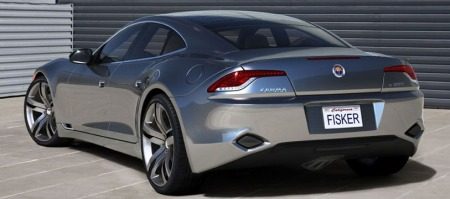
Dit zou het eerste beeld zijn van de productieversie van de Fisker Karma, zoals die in januari onthuld zal worden op de NAIAS in Detroit (is er tenminste nog iets te zien). Tot nu toe moesten we het nog steeds doen met de conceptcar van deze hybride/elektrische voiture.
De Karma zal niet (zoals de Tesla Roadster) een volledig elektrisch aangedreven auto worden. Het zal een plug-in hybrid worden zoals we kennen van de Chevrolet Volt. Naast een elektromotor heeft de Karma ook een viercilinder met 260 pk onder de motorkap, welke helpt bij het opladen van de batterijen.
De eerste 50 mijl (80 kilometer) kan je op 100% elektrische energie rijden en daarna schakelt de verbrandingsmotor bij en rij je in feite hybride. En is dat dan zuinig? Karma zegt dat iemand die ’s nachts zijn auto oplaadt en maximaal 80 kilometer per dag rijdt een gemiddeld verbruik van 2,4 liter per 100 km op jaarbasis(?) kan halen.
En de prestaties? Zoals gezegd kan je maximaal 80 km op louter elektriciteit rijden. Het sprintje van 0-100 gebeurt in iets meer dan 5,8 seconden. De topsnelheid ligt op 200 km/u en de twee elektromotoren leveren maar liefst 408 pk. Alle details (speciaal voor de freaks) kan je hieronder in het persbericht vinden.
Fisker Automotive, Inc., a green American premium sports car company, today announced that its first production car, the Fisker Karma, will be showcased at the North American International Auto Show (NAIAS). With only minor design enhancements made to the exterior of the vehicle, the production Fisker Karma plug-in hybrid retains the extreme proportions and beautiful sculpture of the January 2008 Karma show car.
“We are very excited to be bringing the Fisker Karma back to NAIAS,” said Fisker Automotive CEO Henrik Fisker. “In the year since we debuted the Karma, the reception we’ve received has been tremendous. I’m proud to announce at this time that we are already sold out on the car until mid-2010.”
With a base price of $87,900 (USD), the Fisker Karma is scheduled to begin delivery in November 2009. Featuring the proprietary Q-Drive powertrain, the Fisker Karma will have an all-electric range of 50 miles (80km). After the all electric 50 miles, the gasoline engine turns a generator to charge the lithium ion battery. Once the 50-mile electric range has been exceeded, the Fisker Karma can be used as a normal hybrid vehicle. With this balance of electric and gas range, Fisker Automotive estimates that most Karma drivers who charge the Karma overnight and commute less than 50 miles per day will be able to achieve an average fuel economy of 100 mpg (2.4L/100km) per year.
The production model to be featured at the 2009 NAIAS will include an upper grill that is graphically enhanced, being slightly larger towards the outer corners. The lower air intake has been enlarged to allow for more airflow and underneath the rear bumper, an aerodynamic diffuser includes the integration of a cooling cover for the electric drivetrain.
To optimize cooling and aerodynamics, the exhaust pipe from the ICE engine is routed directly out behind the front wheels. A small functional side vent will release the hot air when the ICE engine is turned on. The Fisker Karma also features a complete flush B-pillar. The B-pillar is a safety feature and already fulfills the proposed 2012 rollover protection safety regulations.
Underneath the Karma is an all aluminum spaceframe made in cooperation with Norsk Hydro. The exterior body is a combination of aluminum panels and composite panels.
The Karma has a unique sustainable interior strategy. The design of the interior cabin is a luxurious tailored space for four adults. The interior will be unveiled for the first time in its final form at the 2009 NAIAS.
The vehicle’s ride and handling is decisively sporty and includes very responsive steering. The Karma’s long wheel base, wide track and low center of gravity provide excellent cornering and stability at highway speeds.
The innovative powertrain, Q-drive, utilizes a large, powerful lithium ion battery and a powerful 2-liter direct injected turbo-charged 4-cylinder gasoline engine developing 260 hp, which enables the Karma to achieve a continuous top speed of 125 mph and a 0-60 of 5.8 seconds. The large powerful lithium ion battery provides 22.6 kWh, which has unique control software. The two powerful electric motors deliver a combined 408 hp.
Additional features of the Karma include:
Karma Powertrain “Q-Drive”
Powertrain Overview DescriptionThe Karma powertrain is a high performance, high efficiency, plug-in hybrid electric system comprised of three electric machines, three inverters, a turbo-charged 2.0 L high-feature DI gasoline engine and an advanced Lithium- ion technology battery pack. This hardware combination coupled with the innovative Q-Drive control system provides for a unique driving experience where energy, power, feel, and fuel economy are optimized to satisfy driver demands.
Energy Storage System
The energy storage system incorporates an advanced lithium-ion chemistry battery pack with integrated control and safety systems that ensure safe and powerful operation throughout the operating life. The system has a maximum storage capacity of 22.6 kW-hrs and is capable of delivering a peak electric power of 200 kW (500 Amps at 400 Volts) throughout the charge depleting range of operation. The Advanced Lithium Power battery pack has been designed for the rigorous requirements of the automotive environment, and is a full “plug and play unit” utilizing all advanced vehicle communications software. The battery pack uses inherently safe cell chemistry and has been designed with multiple levels of software and hardware features to ensure optimal performance while providing the highest levels of safety features.
Powertrain Electric Traction
The power dense dual motor traction drive is capable of delivering a peak output mechanical power of 300 kW (408 hp) and a peak torque of 1300 Nm (959 Ft-lb) to the input of the differential. In Sport mode this provides for a high performance luxury sport sedan acceleration time of 0 to 60 mph (0-100 km/h) in less than 6 seconds. The sustained (electronic limited) top speed is 125 mph (200 km/h).
Karma Powertrain Operating Modes
Stealth
Stealth is the default mode of operation. In this mode of operation the Q-Drive continuously optimizes the system performance and efficiency around fuel economy and electric operation. The high efficiency traction system and stable battery pack operating characteristics provide for full no-compromise electric performance on the urban driving schedule. The total achievable all electric range of greater than 50 miles is realized while in Stealth mode. In this mode the maximum vehicle speed will be limited to 95 mph with slightly limited acceleration. When electric mode is exited, the charge sustaining low energy threshold has been reached. The Q-Drive system then transitions to HEV operation. In HEV mode, the Q-Drive still optimizes fuel economy.
Sport
Sport is a driver selectable feature allowing for enhanced vehicle performance operation. This mode takes full advantage of the peak traction system performance capability and delivers the peak on-demand power and torque in order to achieve a 0 to 60 mph time of 5.8 seconds and a top speed of 125 mph. At anytime the driver can switch between stealth and sport modes. Should the driver wish to change back to Stealth mode, the Q-Drive will transition the vehicle operation to the Stealth mode low energy operating threshold.
HEV
When in HEV or charge sustaining mode the Q-Drive control system operates the vehicle very much the same as a normal strong hybrid. This includes deceleration engine shutdown, zero speed engine-off, electric launch and auto- start capability, and charge sustaining while maintaining charge balancing throughout the customer drive cycle. When the driver is in Sport mode, the Q- Drive automatically transitions to the charge sustaining mode at a higher SOC level than when in Stealth mode. This ensures that sufficient energy is available to support driver demands. Should the driver transition from Stealth to Sport while in HEV mode, the Q-Drive will restore the higher low- energy threshold. This provides for a high performance, on-demand, no- compromise, vehicle operation.
Fuel Economy & Energy Recovery
The Q-Drive system in all modes of operation works synchronously with the regenerative braking system and optimizes the energy recovery around driving conditions, driver demands for downhill simulated engine braking, vehicle speed, and road conditions.
Exterior Design
Eco Chic
Low, wide and coupe-like in profile, sensually sculpted surfaces mix with dramatic and powerful proportions to give the Fisker Karma a “look” all its own. The Karma’s dynamic stance is just as much a thing of beauty as it is a result of the car’s proprietary technical layout. Standard 22-inch light alloy rims at all four corners make Karma a world-leader in the wheel to body relationship. Form and function go hand in hand at Fisker.
Furthermore, innovative and functional design features such as side- mounted charging indicators, state-of-the-art LED-Xenon lighting, unique external-mounted speaker covers and a one-piece solar glass roof work in harmony to express the new design aesthetic that is Eco-Chic.
The exterior design of the production Karma is instantly recognizable and makes no compromises, with only minor changes from the 2008 Karma show car.
Headlamps/Tail lamps
The Karma headlamp combines a Bi-Xenon main lighting module with state-of- the-art LEDs making it one of the most energy-efficient headlamps ever offered. The distinctive bezel design is yet another example of the new Eco- Chic aesthetic.
The tail lamps features state-of-the-art LEDs for low energy consumption
Solar Roof
The Fisker Karma is unique in having the world’s largest continuous formed glass solar roof panel on a car. The splayed solar cell array maximizes solar ray absorption under various lighting conditions. The graphic accent that runs between the solar cells gives the solar roof a unique and futuristic appearance.
Solar Roof Functionality
The Karma solar energy system converts radiated power from the sun into stored electrical energy. All energy gained from the sun supplants that of the batteries and fuel, effectively increasing the electric range of the Karma.
Solar Power Modes
During vehicle on mode and accessory mode, the electrical system will use all available solar power. For vehicle off mode, the driver may choose from 3 solar power strategies.
1. Auto – the Karma will use the solar power for optimal benefit and focus on system efficiency and reduced costs, including energy and longevity. The Karma will use this default strategy unless the driver selects otherwise, and the Karma resets to this strategy after each power-on.
2. Climate – the energy management system will utilize the solar power to ventilate the passenger compartment and reduce the effects of radiant heating. The driver can select this option from the solar menu.
3. Charging – the Karma will store as much energy as possible from solar power. The driver can select this option from the solar menu.
System Architecture
The solar system architecture consists of a the solar panel and power conditioning devices which manage the power delivered utilizing maximum power point (MPP) tracking. The solar panel is comprised of 4 electrically separate zones, each consisting of 20 cells in series. Each of the 4 zones incorporates MPP tracking to maximize power output for various solar radiation angles and partial shading conditions.
As a subsystem, it serves as an integral part of the vehicle onboard energy management strategy to continuously optimizes and manage on board vehicle energy.
Technical Specifications
— 0.5 kWh/day
— 130 WCharging Port
— Locking charging port with lid for 110V and 220V charging on driver’s side rear quarter panel (analog to fuel filler on passenger side)
High-Performance Spaceframe Body Structure
Embodied in the Fisker Karma is a high-performance light-weight aluminum space-frame – developed by the most experienced body structure engineers in the automotive industry. The Karma aluminum spaceframe fulfills high stiffness targets for bending and torsion while fulfilling all current crash standards. The strong aluminum spaceframe allows the driver of the Fisker Karma to experience a new level of body rigidity and damping. The resulting steering feel and the driving dynamics will be unmatched in the 4-door sports sedan class.
The side glass “DLO” appears as one smooth, unbroken curved surface that incorporates a flush B-pillar. Due to the strong B-pillar, the Fisker Karma easily fulfills the proposed 2012 rollover protection rules.
Vehicle Architecture
The Fisker Karma’s vehicle architecture layout features the lithium ion battery packaged into the tunnel enabling a very low center of gravity in the middle of the vehicle – perfect for best driving dynamics and safety. A further advantage of this architecture is the completely closed and rigid body shell that surrounds the driver and the passengers between the front and the rear of the vehicle.
Interior
The final production interior will be unveiled in Detroit at the NAIAS on January 15, 2009.
Chassis – Suspension
Designed to match the unique driving experience of the Fisker Karma’s electric driveline, the suspension system balances attributes of a grand touring sedan with the fun-to-drive characteristics of a legitimate sports car. Using a systems integration approach to the complex tradeoffs of an all new plug-in hybrid platform, engineers were able to meet rigorous functional targets that are competitive with other luxury sports sedans. The design result takes advantage of Karma’s low center of gravity, wide track, and long wheelbase to deliver a unique driving experience with a blend of response and comfort.
Both front and rear suspensions feature a “short long arm” (SLA) architecture with a short spindle height. Similar to that found in many sports cars, the compact package of the SLA suspension is compatible with Karma’s low overall hood height and a dramatic rear end styling.
All suspension components including control arms, knuckles and sub frame are made from lightweight cast aluminum. The liberal use of aluminum in many chassis components reduces the overall weight, including un-sprung weight, to improve agility and ride performance.
The Karma is controlled at each of four wheels with mono-tube shock absorbers that are specifically tuned to improve the level of roll damping, giving a sense of flat cornering with little body roll. The rear shock absorbers are load-leveling, so the vehicle maintains its showroom stature at any loaded condition.
Fundamental to the driver interface, the steering is a hydraulically power-assisted rack and pinion. The hydraulic power unit is electrically driven and tuned for optimum steering feel with a programmable servo assist feature. Steering ratio is 14 to 1, with 2.7 turns lock-to-lock giving remarkable steering responsiveness. Specific focus has been also been given to balancing highway responsiveness with reduced parking efforts, giving a sense of an overall smaller and more nimble vehicle.
Brake Actuation System
— Electro-hydraulic brake boost unit with integral chassis control
functions:
— Brake proportioning
— ABS
— Traction control
— Stability control
— Electrically regenerative brake blending with friction braking— Parking Brake
— Electrically actuated parking brake, bi-directional switch operationChassis – Wheels & Tires
— Tires
— Front: 245/35R22 Michelin Pilot Sport PS2 with optimized rolling
resistance
— Rear: 265/35R22 Michelin Pilot Sport PS2 with optimized rolling
resistanceOverall Vehicle Specifications
— Acceleration (‘sport’ mode)
— 0-60 miles/hour = 5.8 seconds (0-100 km/h in 60 seconds)
— Top speed (continuous) = 125 miles/hour (200 km/h)
— Weight
— curb weight = 4,650 lbs
— Range
— Electric Only Range = 50 miles EPA city cycle
— Total Range = Over 300 miles
— Exterior Dimensions
— Overall Length = 4987 mm
— Overall Width = 1984 mm
— Overall Height = 1330 mm
— Front Overhang = 913 mm
— Rear Overhang = 914 mm
— Wheelbase = 3160 mm
— Front Track = 1689 mm
— Rear Track = 1720 mmPowertrain Specifications:
— Rear Wheel Drive
— Performance:
— Stealth Mode = max 95 mph – battery only
— Performance Mode = max 125 mph (ICE & battery – combined)
— Drive Motor(s) Power = 2 x 150 kW (408 hp)
— Battery Size
— Dimensions = 1870 mm L x 205 mm W x 360 mm H
— Energy Capacity = 22.6 kW hours
— ICE Powertrain = 2.0 Liter DI Turbo Ecotec
— Exhaust System Location = Engine Bay
— Transmission = Not RequiredThe Fisker Karma will be assembled by Valmet Automotive in a highly automized assembly facility. Valmet Automotive is currently producing the Porsche Boxster and Porsche Cayman. The first Fisker Karma will be delivered to customers in November 2009. Yearly volume is anticipated to reach 15,000 cars per year.
A total of 40 retailers for the U.S. will be established by October 2009. Fisker Automotive will announce 20 of their Retailers in January 2009. European pricing will be announced at the International Geneva Motor Show in March, 2009.
En als bonus nog 2 extra (renderings) van de Karma. De Karma zal trouwens in Finland bij Valmet gebouwd gaan worden. (via: thecarconnection.com)
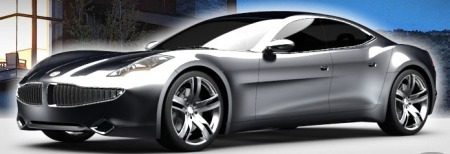
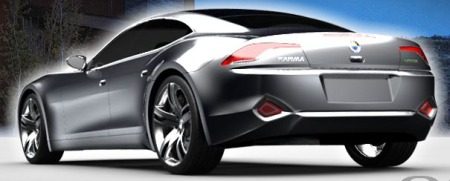
UPDATE 03-12: Onze vrienden van Jalopnik hebben een foto van de voorkant te pakken weten te krijgen.
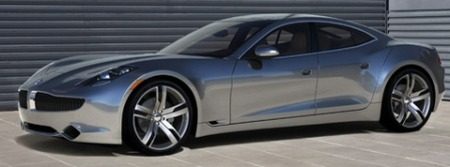

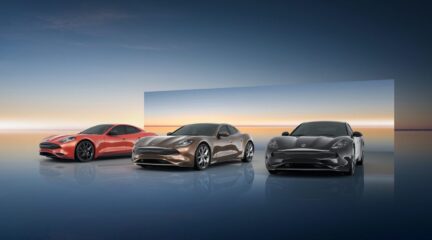
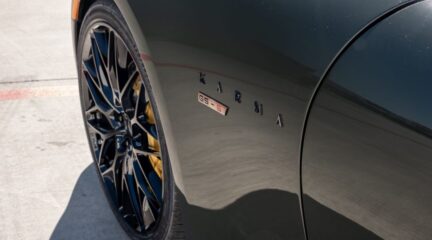
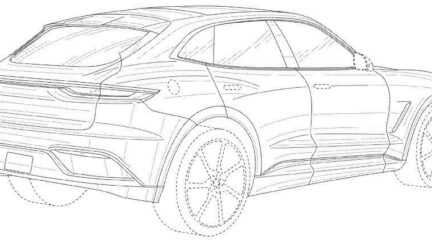
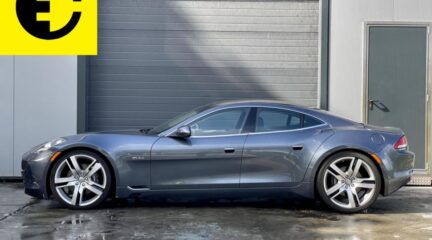




Gister ingehaald door een renault coupe, dacht even dat deze dezelfde achterkant had. Totdat ik het bericht iets beter las.
Neemt niet weg dat het een fraaie verschijning is.
als dat hok 80 km op stroom kan rijden en je rijdt 80 km per dag hoef je toch nooit op benzine te rijden?
heeel gaaf! alleen zou ‘ie ook door kunnen als een 4-deurs Maserati granturismo…
en haal die grijns is van die bumper af… een sportauto moet niet lachen maar agressief kijken!
Booyakasha… Ik vind dit wel vet.. behalve dat interieur met die chromen schis… maar die buitenkant is toit
ziet er goed uit maar die twee foto’s onder het bericht zijn wel echt lelijk
Eén van de mooiste auto’s ooit als je het mij vraagt… Wie weet als ik 18 ben ;)
Achterkant doet me denken aan een renault laguna eerlijk gezegd…
http://www.autoblog.nl/archive/2007/08/19/2008-renault-laguna-fotos
Trouwens nog een leuk weetje! Het gat dat je ziet in het scherm achter het voorwiel, dat is de uitlaat!!!
Er wordt al een tijdje met dit nieuws geadverteerd. Ik was vorige week op het vliegveld in Los Angeles waar men met deze eerste officiele foto’s, ook een dergelijke van de voorkant, reclame maakte op schermen. 100 miles to the gallon werd beloofd en een levering in 2009.
http://www.fiskerautomotive.com biedt aanvullende informatie.
Californië is een belangrijke afzetmerkt, waar de helft van de bevolking milieubewust schijnt te zijn geworden en hybrides rijdt, ondanks het feit dat de benzine daar nu $1,75 per gallon, zeg €0,35 per liter, kost.
Met een topsnelheid van 200 km/u zal je daar de eerste de beste leaseslet ingehaald worden :p
Daar gaan ze toch iets moeten op vinden om echt een doorbraak te forceren als “electric-super/sportcar”.
Dit begint er op te lijken. En voor die prijs sexyer dan welke supercar dan ook.
Zou wel eens een exploded view van het ding willen zien, mij is onduidelijk of de verbrandingsmotor alleen een generator aandrijft, of ook rechtstreeks de wielen.
Beetje flauw trouwens om niet te kijken naar het totale energieverbruik inclusief opladen aan een stopcontact. Maar die stroom is natuurlijk gratis als je je dak vol legt met zonnepanelen.
En dat doen ze allemaal in Californië, en ook nog eens zonder subsidies!
-edit: check!-
@Laurens:
Je bent me net voor… zit ook echt met deze vraag in m’n maag… doet die verbrandingsmotor nou alleen de accu’s laden voor extended range… of neemt ie ook echt via een aandrijflijn de aandrijving op zich…? Da’s ook totaal niet duidelijk voor mij… ik haal het ook steeds niet uit de artikelen zelf over deze auto… dus jongens… wie weet er van de hoed en de rand…?
Het lijkt erop dat de benzinemotor alleen gebruikt wordt voor het bijladen van de accu. Anders haal je dat lage verbruik ook niet.
Jaarbasis kan ermee te maken hebben dat hij in de winter meer verbruikt misschien.
Volgens de bovengenoemde Fisker website drijft de motor een generator aan.
Het lage verbruik is waarschijnlijk gebaseerd op een analyse van het gebruik dat iemand maakt met een auto, derhalve meestal korte ritjes en af en toe een lange rit.
Tijdens zo’n rit zal het ding relatief best veel verbruiken tov een conventionele auto want om stroom eerst op te wekken en dan naar electromotoren te leiden is niet heel efficiënt, anders zouden alle auto’s het hebben.
Fisker gaat er geheel vanuit dat je zonnepanelen op het dak hebt, die kun je zelfs via hen aanschaffen.
Leuk idee al met al, als je nog 6 andere auto’s in de garage hebt is dit zeker iets voor erbij, om de ritjes naar de Oscar uitreiking te maken.
En misschien druppelt de technologie door in modellen voor Jan Modaal.
-edit: idd-
zeer interessante auto!
“De eerste 50 mijl (80 kilometer) kan je op 100% elektrische energie rijden (…). Karma zegt dat iemand die ’s nachts zijn auto oplaad en maximaal 80 kilometer per dag rijdt een gemiddeld verbruik van 2,4 liter per 100 km op jaarbasis(?) kan halen.
Maximaal 80 km per dag, dat is dus nooit meer dan 80 km, anders zou het wel gemiddeld heten. Maar in de zin ervoor staat dat de eerste 80 km volkomen elektrisch is. Elke dag minder dan 80 km rijden, is dus 100% elektrisch, en in liters gezien geen verbruik. Of zie ik dat verkeerd?
schitterend!!!!
nee joh…lijkt helemaaaaaal niet op een maserati (vooral de eerste foto)
Mooi, die achterkant doet me denken aan een citroën
heel de vormgeving doet me denken aan een maserati quatroporte
Niet meteen moeders mooiste, al wil ik de auto wel eerst eens in het echt zien. Alleszins een leuke nieuwkomer.
lijkt op een maserati granturismo?!
Prachtige auto!! Super :D
is 260 pk niet erg veel om enkel wat accu’s te op te laden?
Maserati, sue them!
Het is te hopen dat we snel een nieuwe grote oliebron vinden en dat dhr. Gore eindelijk ontmaskerd wordt als oplichter. Kunnen we ons weer richten op gewone auto’s en gezonde (lees: gemeende) zorg voor de aarde.
… ijdele hoop
Wat een k*tnaam trouwens, karma. Karma, my ass. Er is niks ‘onzelfzuchtigs’ aan, integendeel.
Vreemd: ik heb deze wagen al gezien op een autobeurs in New York in september. Daar namen ze al orders op. (toegeven wel exclusieve beurs maar dan nog)
Kijk, Porsche! Zó ziet een vierdeurs supersportwagen eruit!
Na de verbouwde BMW en SL had ik Fisker al als ontspoorde auto ontwerper afgeschreven. Nou kunnen je stellen dat dit soort mileu modellen ook zeker ontspoort zijn maar hij is niet lelijk en minstens 1056 * zo mooi als de eerdere creaties onder eigen naam van Fisker.
@Roy
Het is waarschijnlijk een parallelle hybride, geen seriële hybride.
@Have a cigar: Karma=’handeling’, ‘actie’ of ‘daad’
Ik geloof dat ik het begrijp. Ze spreken over ‘drive motors’, de electromotoren. Die drijven als enige de wielen aan en krijgen hun stroom uit de accu en de benzinemotor. Omdat de accu een redelijk beperkte capaciteit heeft is een sterk aggregaat nodig. Het verbruik zal een gemiddelde zijn. Iedere dag minder dan 80km is zuiniger en iedere dag meer dan 80km + doorrijden is minder zuinig. Dus Duitsers die iedere dag meer rijden dan die 80km en bovendien alleen maar volgas rijden komen niet veel gunstiger uit dan een sterke diesel, denk ik.
Het is zowel een serial en parallele hybride. In de Stealth Mode laadt de benzinemotor (260 pk) het accupack op en zorgt alleen de electromotor (plm. 270 pk) voor de aandrijving. In Performance Mode zorgen ze sámen voor de aandrijving en is er in totaal 408 pk beschikbaar. Vandaar die 5,8 sec naar de honderd voor een 2100 kg zware auto.
@Bashjuh: die grijnzende grille zit op het studiemodel en daar waren nogal wat aanmerkingen op. In het productiemodel is de grille iets aangepast waardoor hij minder grijnst.
Dacht ff dat China weer aan ’t kopiëren was geweest
UPDATE Onze vrienden van Jalopnik hebben een foto van de voorkant te pakken weten te krijgen.
Jan C.
Je hebt gelijk.
Een slechte daad dus in dit geval.
;-)